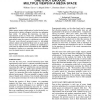Free Online Productivity Tools
i2Speak
i2Symbol
i2OCR
iTex2Img
iWeb2Print
iWeb2Shot
i2Type
iPdf2Split
iPdf2Merge
i2Bopomofo
i2Arabic
i2Style
i2Image
i2PDF
iLatex2Rtf
Sci2ools
CHI
1993
ACM
1993
ACM
One is not enough: multiple views in a media space
Media spaces support collaboration, but the limited access they provide to remote colleagues' activities can undermine their utility. To address this limitation, we built an experimental system in which four switchable cameras were deployed in each of two remote offices, and observed participants using the system to collaborate on two tasks. The new views allowed increased access to task-related artifacts; indeed, users preferred these views to more typical "face-to-face" ones. However, problems of establishing a joint frame of reference were exacerbated by the additional complexity, leading us to speculate about more effective ways to expand access to remote sites. KEYWORDS cscw, social interaction, media spaces, video
| Added | 09 Aug 2010 |
| Updated | 09 Aug 2010 |
| Type | Conference |
| Year | 1993 |
| Where | CHI |
| Authors | William W. Gaver, Abigail Sellen, Christian Heath, Paul Luff |
Comments (0)

